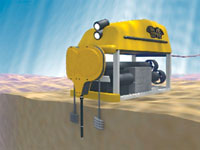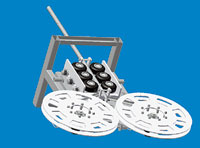 Technology from Europe: Technology from Europe:
Norway/Finland
Soil investigation tool passes commercial hurdle
Bjarte Langeland, Stinger Technology AS, Stavanger
Soil Stinger, a lightweight, cost-efficient tool for shallow soil investigation, is about to make its commercial debut. In recent field trials, the unit was mechanically tested, and its strength was confirmed. Furthermore, the unit was tested onshore, and the patented technology has proved to work as designed.
The Stinger is tailored toward ROV operation, and suitable for use close to existing installations. Subsea contractors thus have another tool at their disposal, to handle such requirements as hookup of wells, installation of new pipelines, etc. They will be able to offer low-cost soil investigations, either as a dedicated service or as an added value.
Compared to traditional equipment, the device can cover most shallow soil investigations at a low cost utilizing standard ROV capacity. Primary tasks include:
- CPT (Cone/Piezo Cone Penetration Test)
- Chemical, electro-magnetic and other tests
- Core sampling
- Seabed sampling
- Soil data for seismic investigations.
The Stinger can perform investigations on the seabed (CPT/samples) using standardized geo-technical testing equipment. The geometry of the cone penetrometer (cross section of 1,000 mm2 ), with tip, sleeve and pore pressure filters, follows the International Reference Test Procedure for Cone Penetration Test (IRTP, 1999). The unit features a very low apparatus height and continuous, rather than stroke-based, penetration and retraction of the cone penetrometer.
 |
 |
The Soil Stinger (top and bottom) conducts soil investigations at a lighter weight than traditional units, generating better data at lower costs.
|
|
Advantages. Stinger technology is lightweight and requires less space compared to alternative technologies. The user-friendly system is container-based for efficient transportation and storage. When ROV-mounted, the system is flexible on survey location. It also takes advantage of the ROV's capability to document accurate positions for tests and samples.
There are no water depth limitations (within the ROV's capabilities), and the system can perform multiple tests and samples in one dive at well-defined interrelated distances. Deployment, equipment requirements, testing, data acquisition, calibration, required accuracy and presentation of results follow the latest NORSOK and international standards.
Addressing specific needs. In recent meetings, Stinger Technology and its partners focused on some concerns and challenges in the near future for core businesses. Among these items, pipelaying contractors have not been able to verify and document sufficient soil data after trenching and backfill of pipelines. The Stinger can go close to existing structures, position itself relatively accurately in the middle of a filled trench or in a pockmark, and take repeated measurements at well defined, interrelated distances.
Large, heavy soil investigation rigs can cause additional stress on the sea bottom. This can influence the readings obtained. The new unit will leave a light footprint and, thus, undisturbed CPT data.
The Soil Stinger Tool will be presented at this year's Offshore Northern Seas (ONS) conference in Stavanger. 
|

 Technology from Europe:
Technology from Europe:


